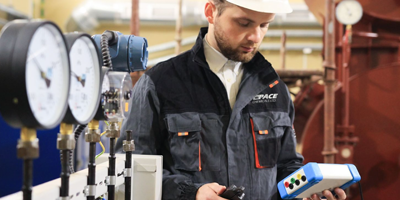Legionella Management
Managing the Risk
Legionella risk management is important in preventing the bacteria that causes Legionnaires’ disease. By using effective treatment programs and services, Pace helps you with microbial control while improving public safety.
Risk Management Programs
Our focus is educating and assisting our clients to minimize the risk for Legionella bacteria in their cooling water systems by recommending the implementation of best practices based upon industry standard guidelines.
What is Legionella?
Legionella is the bacteria that causes Legionnaires’ Disease, a deadly respiratory infection that leads to severe pneumonia-like symptoms. Commonly found in stagnant water at temperatures between 20°- 50°C (68º – 122º F), it thrives in biofilm, scale, and sediment.
Legionella can survive chlorinated potable water by living in certain amoeba and ciliated protozoa, allowing them to appear in finished water supplies to homes, buildings and industrial sites.
Legionella In Buildings
The most common outbreaks of Legionella have occurred in buildings and facilities with mismanaged systems. Areas in buildings where the bacteria thrive are:
- Cooling towers on roofs where standing water is common
- Whirlpool bathtubs, hot tubs, and public spas where water and fouling can occur in system pipes
- Plumbing systems from water heaters to faucets and showerheads
- HVAC systems where water condensation can collect and pool

Related Article
Preventing Legionella in High Traffic Public Spaces
After a long closure due to the pandemic, an indoor public ice rink in the Greater Toronto Area (GTA) in Ontario, Canada, experienced a potential legionella outbreak.
Minimizing the Risk of Legionella
The water treatment objectives are to prevent corrosion, scale deposits, pipe fouling, and microbiological control.
- Biocide treatments play an important role in microbiological control programs
- Bio-dispersants loosen microbial deposits, promote system cleanliness and penetrate biofilm
- An annual/bi-annual cooling tower disinfection procedure is recommended to promote system cleanliness and disease prevention
Pace Legionella Policy Guideline “Legionella Risk Management of Cooling Water Systems” covers:
Since there is no guarantee to eliminate the health risk associated with Legionella bacteria or any potential outbreaks in cooling water systems, our primary focus is to educate and help our clients minimize the risk for Legionella in their cooling water system(s) by recommending they implement all best practices, many which are outlined in our Pace Legionella Policy Guideline. Examples of topics covered in our policy include:
- Recommended best practices to minimize risk
- Legionella background and general facts
- Routine cleaning and disinfection procedure
- Water treatment program parameters
- Maintenance inspections
- Legionella testing
- Decontamination procedure
- Legionella publications and resources
If you would like more information on how to implement the Pace Legionella Policy Guideline for your cooling tower management plan, please contact us at the Pace Legionella Team.

Related Article
Testing and Treating Water for Legionella
Energy saving additives for hydronic systems are the simplest way to instantly reduce building energy consumption and emissions by up to 15%.
Testing for Legionella
As per the Public Works and Government Services Canada (PWGSC) Document MD 15161 2013, Pace recommends that Legionella sampling and testing should be done monthly on cooling tower systems, or more frequently if the weekly TBC bacterial counts are excessively high or if heavy biofouling is evident in the cooling tower system. Pace utilizes an independent CALA Accredited and CDC Elite Certified Laboratories for Legionella Analysis using ISO 11731 methodology for culture testing method.
Pace Solutions also provides rapid on-site DNA detection of Legionella bacteria. This testing service will provide highly accurate qPCR analysis in 45 minutes, compared to waiting weeks with the standard culture test method. Unlike lab-based qPCR methods, this proprietary technology detects live and not dead bacteria, utilizing a test method that is validated according to ISO 12869. This DNA-based diagnostic technique allows Pace to provide their clients with;
- Fast (<1 hour) and accurate detection of Legionella on site
- Immediate validation of Legionella remediation effectiveness
- Immediate validation of Legionella risk management program
- Preventing & addressing potential Legionella outbreaks before they occur at your site
- An additional testing method to be used in parallel with your existing testing method to provide the most comprehensive prevention program
For more information on how Pace can implement DNA detection of Legionella at your site(s), contact the Pace Legionella Team.

Related Article
Vancouver Legionella Testing Bylaw Compliance
Let Pace Manage Your Cooling Tower Operating Permit, Legionella Testing and EOCP Certification!
Developing a Water Management Plan (WMP)
We will help you create and implement a compliant, comprehensive, and defensible Legionella WMP. Then we’ll provide support and service for ongoing compliance. The Pace WMP and service will:
- Identify the internal water management plan team
- Conduct site surveys
- Generate system descriptions & flow diagrams
- Establish control measures, monitoring limits and corrective actions
- Verification procedures
- Validation methods
- Create a legionnaires outbreak response plan
- Continued and professional communication to the customer
Pace has also partnered with HC Info which provides a cloud-based application (LAMPS) for water management plans, analytics, and training. LAMPS is used to minimize the risk of disease caused by Legionella and other harmful bacteria emitted from water systems in hospitals, nursing homes, hotels, and other large buildings. Pace customers receive a partner code discount from HC Info for their LAMPS Water Management Plans.
Application






Resources
FAQ
Legionella pneumophila is a very common organism, capable of being present in appreciable numbers in almost all ground and surface water sources. Legionella tend to grow in biofilms or slime on the surfaces of lakes, rivers and streams and very adaptively, within water distribution systems such as cooling towers and evaporative condensers. The mere presence of Legionella does not by itself result in infectious disease. However, when certain Legionella multiply, (increase in population density) and transmit to a susceptible human host, they can cause Legionellosis infections.
No, treatment will not eliminate the risk but it can certainly minimize the risk of legionella. Small amounts of legionella pneumophila can be present in the water supply so chemical treatment alone cannot completely eliminate all risk. Treatment is designed to minimize the risk by preventing legionella from multiplying within the cooling tower, decreasing the likelihood of transmission to people.
Yes it is recommended. Sampling and testing for Legionella is useful in helping assess risks and in determining whether or not preventative and corrective measures are working. Having an action plan based upon results of Legionella sampling can alert you to increased risks and whether or not decontamination procedures should be implemented. There is no risk for Legionnaires Disease if there is no Legionella. The only practical way to know if you have Legionella is to test for it.
As per the Public Works and Government Services Canada (PWGSC) Document MD 15161 2013, Pace recommends that Legionella sampling and testing should be done monthly, or more frequently if the weekly TBC bacterial counts are excessively high or if heavy biofouling is evident in the cooling tower system.
Pace utilizes an independent CALA Accredited and CDC Elite Certified Laboratories for Legionella Analysis using ISO 11731 methodology for culture testing method.
Additionally, Pace provides real-time DNA testing services for Legionella using qPCR ISO 12869 methodology, which can be particularly beneficial to detect the immediate presence of Legionella bacteria. The qPCR testing method is also recommended following the cleaning/sanitization and decontamination procedures.
According to the Centre for Disease Control, Legionella can become a health concern when it grows and spreads in human-made building water systems like;
- Showerheads and sink faucets
- Cooling towers (structures that contain water and a fan as part of centralized air cooling systems for building or industrial processes)
- Hot tubs that aren’t drained after each use
- Decorative fountains and water features
- Hot water tanks and heaters
- Large plumbing systems
The CDC recommends the development and implementation of a Water Management Plan to minimize the spread of legionellosis for all applicable water systems in a building. This includes buildings that have water systems such as;
- Domestic hot water tank and system
- Hot tubs and spas
- Ornamental fountains
- Humidifiers, Misters, air washers
- Other non-potable water systems
- Cooling tower systems
To determine what water systems in your building should be included in your Building Water Management Plan, click on our ASHRAE 188-2021 Summary Technical Bulletin which outlines the applicable systems by conducting a survey of the building’s risk factors.
Quick Contact
Fill out this form and we'll get back to you very shortly.
For more ways to get in touch with Pace locally, visit our Contact Us page.





